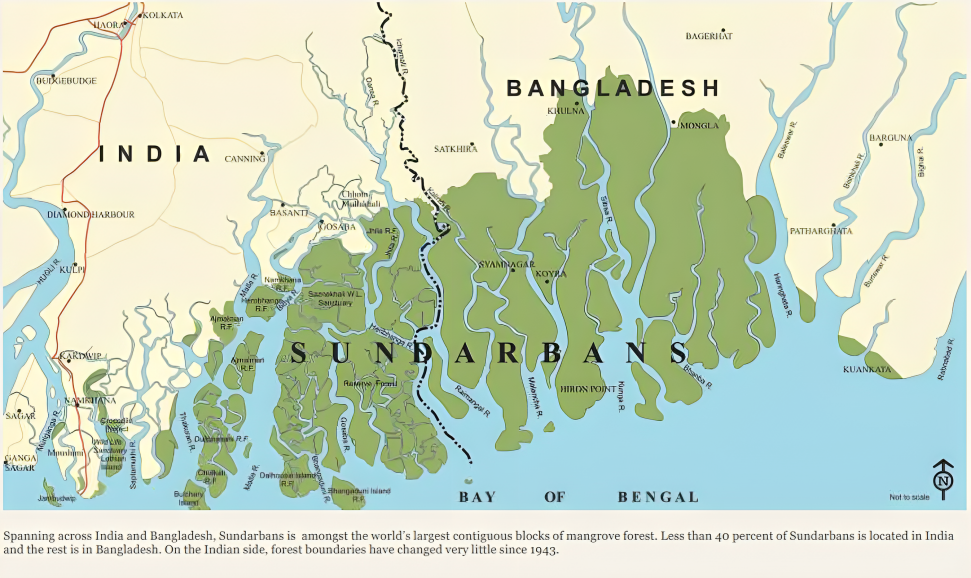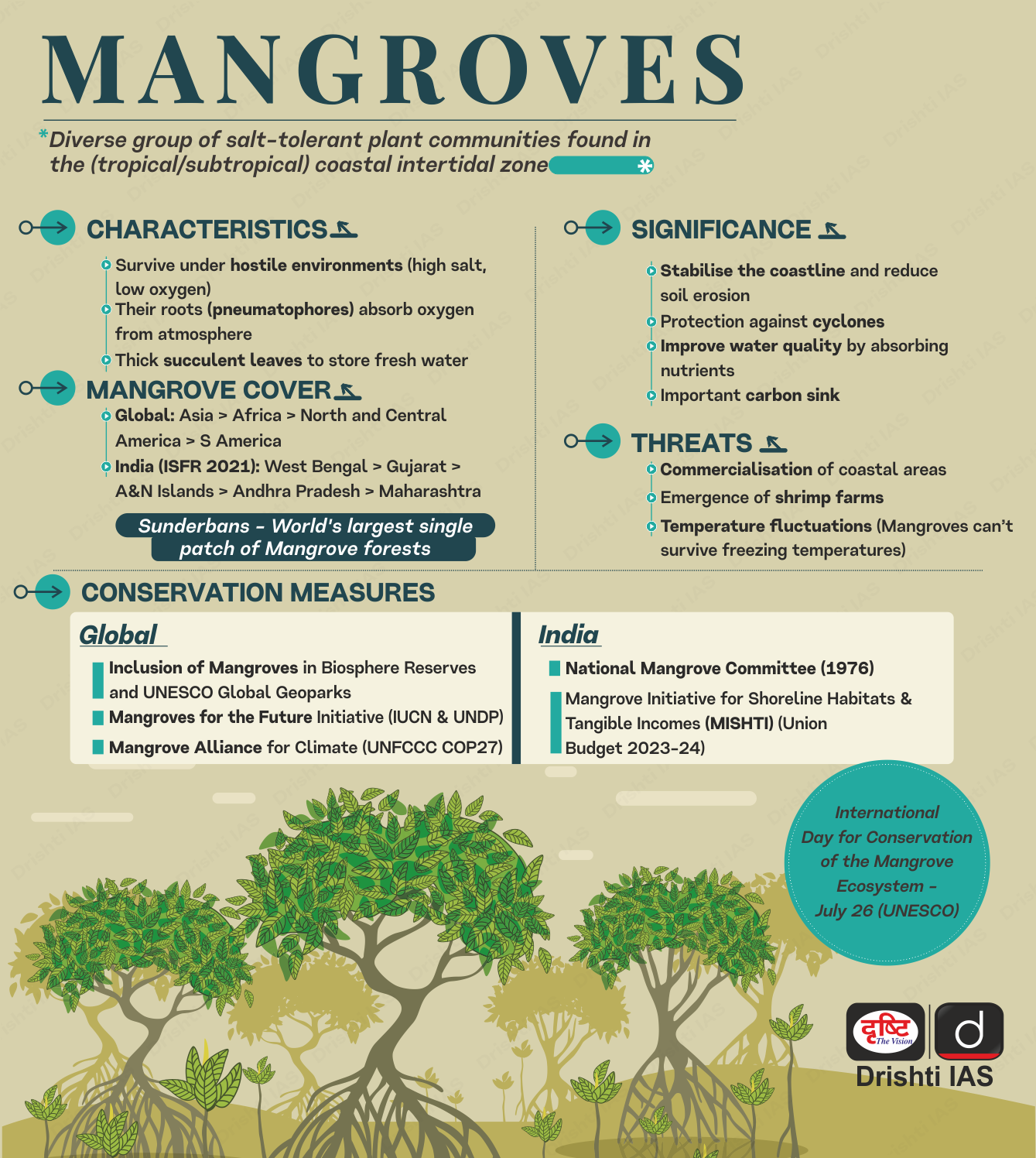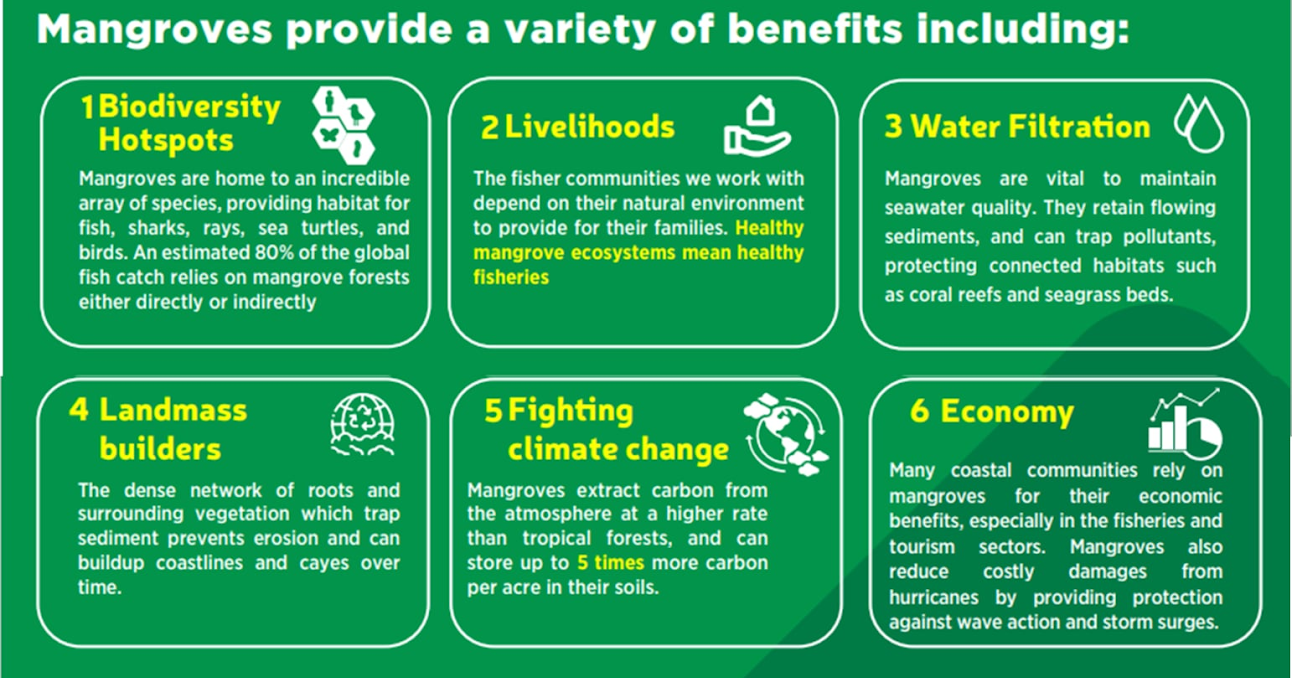Sundarbans’ SAIME Model Wins FAO Global Recognition | 17 Oct 2025
Why in News?
Sustainable Aquaculture in Mangrove Ecosystems (SAIME) model developed by the Nature Environment and Wildlife Society (NEWS) in West Bengal’s Sundarbans has been conferred Global Technical Recognition by the Food and Agriculture Organization (FAO) of the United Nations.
What is the SAIME Model?
- About: It is a community-based initiative in the Sundarbans, West Bengal, that aims to balance mangrove conservation with aquaculture-based livelihoods.
- Under this model, 5–30% of aquaculture pond areas are kept under mangrove cover, protecting the ecosystem while supporting fish and shrimp farming.
- Farmers use mangrove litter as natural fodder for the Black Tiger Shrimp (Penaeus monodon), a high-value species traditionally farmed in the region, thereby reducing dependence on chemical inputs.
- The approach promotes climate-adaptive aquaculture, helping farmers increase profits and strengthen coastal resilience against sea-level rise and erosion.
- Impact: The SAIME Model has doubled farmers’ annual net profits by cutting down on production costs.
- The SAIME approach is climate-adaptive, addressing the threats of sea-level rise and salinity intrusion in the deltaic Sundarbans.
- Mangroves integrated into ponds act as natural carbon sinks, aiding carbon sequestration and mitigating local climate impacts.
- By balancing economic needs with environmental responsibility, it demonstrates a scalable solution for coastal livelihood resilience.
- The model contributes directly to global climate goals under the FAO’s sustainable food systems and ecosystem restoration frameworks.
Sundarbans
- Geographical Distribution: The Sundarbans hosts the largest mangrove forests in the world, located on the delta of the Ganges, Brahmaputra, and Meghna rivers along the Bay of Bengal.
- It is a unique mangrove ecosystem that lies between land and sea, consisting of a mosaic of islands constantly shaped by tidal waters, and is spread across India and Bangladesh in tropical and subtropical zones.
- Biological Landscape:
- Flora: Dominated by Heritiera fomes (sundari), Excoecaria agallocha (gewa), Ceriops decandra (goran), and Sonneratia apetala (keora).
- Salinity increase is replacing tall trees with dwarf species, changing forest structure.
- Fauna: Bengal tiger, Gangetic and Irrawaddy dolphins, estuarine crocodiles, and olive ridley turtles.
- Ecological Role: It acts as a nursery ground for fish, crabs, and shrimp; mangroves buffer coasts against storms and store carbon.
- Flora: Dominated by Heritiera fomes (sundari), Excoecaria agallocha (gewa), Ceriops decandra (goran), and Sonneratia apetala (keora).
- Socio-Economic Landscape:
- Livelihoods: More than 12 million people (4.5 million in India and 7.5 million in Bangladesh) live in this estuarine ecosystem.
- Cultural Harmony: Traditional beliefs, folklore, and rituals emphasize respect for nature, e.g., Bonbibi worship symbolizes coexistence between humans and wildlife.
- Protection:
- The Sundarbans was designated a UNESCO World Heritage Site in 1987 in India and 1997 in Bangladesh.
- Sundarban Wetland (India) was declared a Wetland of International Importance under the Ramsar Convention in 2019.
- India–Bangladesh MoU (2011) was signed to promote joint conservation and monitoring of the Sundarbans’ shared ecosystem.
- The Sundarbans Biosphere Reserve (BR) includes multiple national parks and wildlife sanctuaries, such as:
- Sundarbans National Park (India)
- The Sundarban Wildlife Sanctuaries in Bangladesh are part of a large mangrove forest.
- Sundarbans Reserve Forest (Bangladesh)
What is the Significance of Mangroves?
- Carbon Sequestration: Mangroves are powerful blue carbon sinks, storing tonnes of carbon per hectare due to slow decomposition in their saline, oxygen-poor soils.
- Coastal Protection: They act as natural barriers against storms, tsunamis, and erosion reducing wave energy by 5–35% and flood depths by up to 70%, safeguarding coastal communities.
- Biodiversity Hotspots: Home to over 5,700 species in India mangroves are vital for ecological balance.
- Mangroves support global fisheries, nurture marine species, and provide honey, fruits, and leaves, sustaining millions of coastal livelihoods.
What are the Major Threats and Conservation Strategies for India's Mangrove Ecosystem?
|
Aspect |
Threat |
Conservation Strategy |
|
Land Conversion |
Large-scale clearing of mangroves for aquaculture, oil palm, and rice cultivation has led to significant loss of mangrove cover. |
Enforce stricter coastal zoning and land-use regulations. Integrate mangrove buffers in coastal development plans. |
|
Timber Extraction & Charcoal Production |
Unsustainable logging and wood harvesting degrade mangrove ecosystems, reducing biodiversity and carbon sequestration capacity. |
Promote alternative livelihoods for local communities. Strengthen enforcement under the Forest Conservation Act, 1980. |
|
Pollution |
Oil spills, industrial effluents, and plastic waste hinder mangrove regeneration and soil quality. |
Implement phytoremediation and cleanup drives. Impose strict liability for oil and chemical spills. |
|
Invasive Species |
Species like Prosopis juliflora outcompete native flora, alter soil salinity, and obstruct mangrove regeneration. |
Use bio-restoration methods and native species replantation for protecting the native species. |
|
Climate Change & Sea-Level Rise |
Increased salinity, coastal erosion, and submergence threaten mangrove habitats. |
Strengthen Blue Carbon Initiative participation. Build climate-resilient mangrove belts. |
Conclusion
The SAIME model shows how mangrove conservation and aquaculture can coexist, boosting livelihoods and climate resilience. It reduces carbon emissions while protecting coastal ecosystems and promoting sustainable and inclusive growth.
|
Drishti Mains Question: How does the SAIME model in the Sundarbans integrate livelihood security with mangrove conservation? |
Frequently Asked Questions (FAQs)
1. What is the SAIME model?
The Sustainable Aquaculture in Mangrove Ecosystems (SAIME) is a community-based initiative in the Sundarbans that balances mangrove conservation with aquaculture livelihoods.
2. Which species is primarily farmed under SAIME?
Black Tiger Shrimp (Penaeus monodon) is the main species, with mangrove litter used as natural fodder, reducing chemical inputs.
3. What is the geographical spread of the Sundarbans?
The Sundarbans spans India and Bangladesh, forming the largest mangrove forest on the delta of the Ganges, Brahmaputra, and Meghna rivers, covering 10,000 km².
UPSC Civil Services Examination, Previous Year Question (PYQ)
Prelims:
Q. Consider the following protected areas: (2012)
- Bandipur
- Bhitarkanika
- Manas
- Sundarbans
Which of the above are declared Tiger Reserves?
(a) 1 and 2 only
(b) 1, 3 and 4 only
(c) 2, 3 and 4 only
(d) 1, 2, 3 and 4
Ans: (b)
Mains
Q. Discuss the causes of depletion of mangroves and explain their importance in maintaining coastal ecology. (2019)



